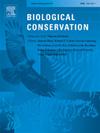Modeling spatiotemporal variations in the density of unmarked populations using camera trap data: An application to free-roaming cats
IF 4.9
1区 环境科学与生态学
Q1 BIODIVERSITY CONSERVATION
引用次数: 0
Abstract
Camera traps have revolutionized wildlife monitoring, providing reliable information on animal occupancy and abundance. In recent years, several models have been developed to estimate the absolute density of unmarked populations (i.e., those lacking individually recognizable markings), which was previously challenging. By refining these models, they may become efficient monitoring tools applicable to a wide range of species. In this study, we extended one such model, the Random Encounter and Staying Time (REST) model, within a state-space framework to explicitly account for spatiotemporal variations in animal density. We applied this model to free-roaming cats using data obtained from 209 camera traps deployed across a study area (836 km2) over a two-year period (June 2018–May 2020). The estimated cat density was generally <0.3 cats per km2, with higher densities observed near human settlements and occasional excursions into deeper forested areas (>500 m). Densities also exhibited seasonal variation, with higher values in winter and spring compared to summer. Our model estimates the “average” density of animal individuals available to camera traps over the temporal duration of interest. Although this metric differs from conventional population density measures and requires careful interpretation, it remains a valuable indicator of the ecological impact or functioning of animals, including free-roaming cats.
求助全文
约1分钟内获得全文
求助全文
来源期刊

Biological Conservation
环境科学-环境科学
CiteScore
10.20
自引率
3.40%
发文量
295
审稿时长
61 days
期刊介绍:
Biological Conservation is an international leading journal in the discipline of conservation biology. The journal publishes articles spanning a diverse range of fields that contribute to the biological, sociological, and economic dimensions of conservation and natural resource management. The primary aim of Biological Conservation is the publication of high-quality papers that advance the science and practice of conservation, or which demonstrate the application of conservation principles for natural resource management and policy. Therefore it will be of interest to a broad international readership.
 求助内容:
求助内容: 应助结果提醒方式:
应助结果提醒方式:


